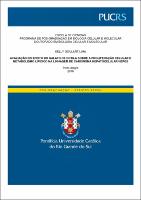| Share record |


|
Please use this identifier to cite or link to this item:
https://tede2.pucrs.br/tede2/handle/tede/7983| Document type: | Tese |
| Title: | Avaliação do efeito do galato de octila sobre a proliferação celular e metabolismo lipídico na linhagem de carcinoma hepatocelular HepG2 |
| Author: | Lima, Kelly Goulart  |
| Advisor: | Oliveira, Jarbas Rodrigues de |
| Abstract (native): | O galato de octila (GO) é um antioxidante utilizado na indústria de alimentos, cosméticos e de medicamentos que tem mostrado efeito antitumoral em linhagem celular de leucemia, melanoma e linfoma de células B, assim como em modelo animal de metástase pulmonar. O Carcinoma hepatocelular (CH) é o principal câncer primário hepático que afeta a população mundial. Embora a ressecção cirúrgica, a ablação e o transplante hepático sejam considerados terapias curativas, poucos pacientes são elegíveis. A aplicação dessas opções terapêuticas é indicada somente para estágios iniciais da doença e infelizmente a maioria dos pacientes é diagnosticado em estágio avançado. Além disso, existem relatos na literatura de resistência à única droga aprovada para tratamento sistêmico, o sorafenibe. Nesse estudo, nós investigamos o efeito do GO sobre a proliferação celular e metabolismo lipídico nas células de carcinoma hepatocelular HepG2. Além disso, desenvolvemos um protocolo para avaliação quantitativa de gotas lipídicas. Nós reportamos, pela primeira vez, que o tratamento com GO por 24 horas inibiu a proliferação das células HepG2 por reduzir a atividade e massa mitocondrial, que levou à redução dos níveis de ATP. Essa redução no fornecimento de energia desencadeou a diminuição na expressão da proteína Ki67, levando à parada do ciclo celular em fase S. Além disso, o uso de dois tratamentos com GO com intervalo de 24 horas induziu perda da funcionalidade mitocondrial e apoptose, sem induzir resistência. Esses resultados mostraram que o GO tem como alvo a mitocôndria, sendo um candidato para novas pesquisas sobre terapias para o CH. Reportamos também, pela primeira vez, o efeito do GO sobre o metabolismo lipídico, visto que nossos resultados mostraram que o composto foi capaz de aumentar a quantidade de lipídeos, os níveis de triglicerídeos e a área de gotas lipídicas, sem envolver a via de sinalização mTOR/SREBP-1c ou a modificação da expressão dos genes PPAR-α e PPAR-γ. Uma vez que a capacidade do GO em inibir a atividade mitocondrial e induzir a apoptose é conhecida, é fortemente sugerido que a redução da β-oxidação mitocondrial de ácidos graxos esteja envolvida no mecanismo do GO no acúmulo de lipídeos. Descrevemos também, pela primeira vez, um protocolo para avaliação quantitativa de gotas lipídicas usando microscopia confocal de varredura a laser que comparado à microscopia de fluorescência convencional, proporcionou grande ganho na qualidade das imagens. |
| Abstract (english): | Octyl gallate (OG) is an antioxidant used in the food, cosmetic and medications industries that has shown antitumor effect on cell lineage of leukemia, melanoma and B cell lymphoma, as well as on animal model of pulmonary metastasis. Hepatocellular carcinoma (HC) is the main primary liver cancer affecting the world's population. Although surgical resection, ablation and liver transplantation are curative options, few patients are eligible for these therapies. The application of these therapeutic options is indicated only in the early stages of the disease and unfortunately most patients are diagnosed at advanced stage. In addition, there are reports in the literature of resistance to the only drug approved for systemic treatment, sorafenibe. In this study, we investigated the effect of OG on cell proliferation and lipidic metabolism in hepatocellular carcinoma HepG2 cells. Moreover, we developed a protocol for the quantitative evaluation of lipid droplets. We report, for the first time, that treatment with OG for 24 h inhibited HepG2 cell growth by decreasing mitochondrial activity and mass, which led to the reduction of ATP levels. This reduction in the energy supply triggered a decrease in Ki67 protein expression, leading to cycle arrest in S phase. In addition, the use of two treatments with OG with interval 24 hours induced loss of mitochondrial functionality and apoptosis without inducing resistance. These results showed that OG targets the mitochondria and is a candidate for new research on therapies for CH. We also report, for the first time, the effect of OG on lipidic metabolism, since our results showed that OG was able to increase the amount of lipids, triglyceride levels and the area of lipid droplets without involving the mTOR/SREBP-1c signaling pathway or modification of PPAR-α and PPAR-γ gene expression. As the ability of OG to inhibit mitochondrial activity and induce apoptosis is known, it is strongly suggested that reduction of mitochondrial fatty acid b-oxidation is involved in the OG mechanism in the accumulation of lipids. We also describe, for the first time, a protocol for the quantitative evaluation of lipid droplets using confocal laser scanning microscopy that compared to conventional fluorescence microscopy, provided great gain in the quality of the images. |
| Keywords: | Galato de Octila Carcinoma Hepatocelular Células HepG2 Antiproliferação Metabolismo Lipídico |
| CNPQ Knowledge Areas: | CIENCIAS BIOLOGICAS::BIOLOGIA GERAL |
| Language: | por |
| Country: | Brasil |
| Publisher: | Pontifícia Universidade Católica do Rio Grande do Sul |
| Institution Acronym: | PUCRS |
| Department: | Escola de Ciências |
| Program: | Programa de Pós-Graduação em Biologia Celular e Molecular |
| Access type: | Acesso Aberto |
| Fulltext access restriction: | Trabalho será publicado como artigo ou livro |
| Time to release fulltext: | 24 meses |
| Date to release fulltext: | 04/05/2020 |
| URI: | http://tede2.pucrs.br/tede2/handle/tede/7983 |
| Issue Date: | 27-Mar-2018 |
| Appears in Collections: | Programa de Pós-Graduação em Biologia Celular e Molecular |
Files in This Item:
| File | Description | Size | Format | |
|---|---|---|---|---|
| TES_KELLY_GOULART_LIMA_COMPLETO.pdf | KELLY_GOULART_LIMA_TES | 12.71 MB | Adobe PDF |  Download/Open Preview |
Items in DSpace are protected by copyright, with all rights reserved, unless otherwise indicated.




